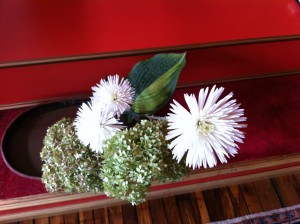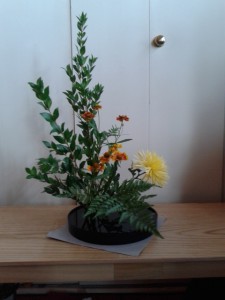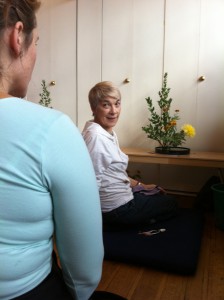Monday
Arts and PoetryKado: Being Quiet and Doing Something!
COLUMN: Celebrating the Artsby Jacqueline Larson, Toronto, Ontario, Canada
More than knowing a thing or two about flowers, Marcia Wang Shibata knows her own mind — but then, she’s been following the way of flowers for a long time. Ms. Shibata, a Master Shambhala Kado Instructor, was in Toronto recently to work with a dozen or so students in an introductory practice.
Kado is an anglicized version of a Chinese word that means the way of flowers. The discipline originated in China over 2300 years ago. When it was introduced and assimilated into Japan, it became ikebana, meaning “living or natural flowers.” Kado is a contemplative practice that studies nature as it is. The aim is not to make conventional beautiful arrangements but to replicate direction of light, non-competition of flowered stems placed following a natural hierarchy in a disciplined, orderly way. The kado discipline helps people see how the wisdom in nature and their innate wisdom are the same.
On Friday night Marcia kept repeating some lines from Lao Tzu. By the end of the weekend these words were sinking in:
Do you have the patience to wait
Till your mud settles and the water is clear?
Can you remain unmoving
Till the right action arises by itself?
 Tristan Lyons from Hamilton said that before the course, “it was like a brick wall. You’d move flowers around in a vase and then you’re done. That’s it. But now there’s a whole path that’s opened up…I feel there’s a way to work with space, not just move things around randomly.”
Tristan Lyons from Hamilton said that before the course, “it was like a brick wall. You’d move flowers around in a vase and then you’re done. That’s it. But now there’s a whole path that’s opened up…I feel there’s a way to work with space, not just move things around randomly.”
Marcia reminded us not to expect more of flowers than what they can give — just like working with people. It’s about non-manipulation and working with things as they are. She also said that kado can teach us about when to speak and when to shut up, about offering what is actually helpful. It’s meditation in action. “You have to be quiet and do something!” she said. (Sangye Martin posted this video about the how the kado class sounded.)
Simone Moir had this to say about her experience of the weekend: “I was quite surprised that the confines of a traditional style could be so freeing, so joyful…The final work is a representation of your mind and reflects basic principles of how the world works in relationship. The materials are to be collected locally and so they mirror what is happening right now in the season rather than a clichéd idea of the season. I have already found my connection to the natural world deepen through this practice over the weekend. I found that paying close attention to the basic laws of growth (observing how a stem grows toward space and light) is deeply reassuring. And then my eye was quite changed at work and riding through the streets too.”~~
Learn more about the way of flowers by clicking here.









Dec 12, 2014
Reply
This article is simple and beautiful. thank you for sharing. It inspires me in my ikebana practice.